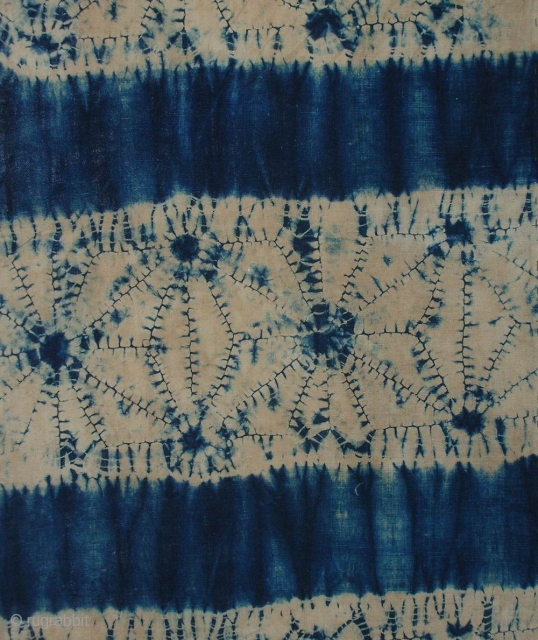Back
Indigo Kumo shibori koshimaki , Japan, late Meiji (c.1900), 111x65cm. The common English translation of the Japanese word shibori is "tie-dye"; however, a more accurate translation is "shaped-resist dyeing," which describes the inherent patterning process of manipulating the two-dimensional cloth surface into three-dimensional shapes before compressing them to dye. Diverse shibori techniques are used to obtain different patterns, and sometimes they can be combined to obtain a certain result. This is the case with the present item, part of a lovely indigo shibori cotton koshimaki (underkimono), that is a short sarong-like garment that is worn for warmth and support. This piece features large and small spider-webs of kumo shibori, divided by belts of great indigo colour. Kumo shibori has long been known in Japan. a twelfth-century painting shows a simple hemp garment with a pattern that resembles this type of shibori. It appears frequently in the ukiyo-e (wood-block prints) of the Edo period (1603-1868), which depict the lives of people from all parts of society. In the nineteenth century, an unusually fine type of pleated and bound kumo shibori dyed in indigo on fine cotton became very fashionable. The present cloth, obtained by sewing together two smaller ones, shows how the ability of a master-dyer can lead to eye-catching results. Condition is not exactly mint, the main issues being a hole at top (ca. 5cm long), and a rather strong age patina. i will therefore include in shipment to buyer a third panel from same koshimaki to be eventually used for mending the hole. Re. patina, to me it is not an issue, rather an added value to the look of cloth, but this is of course my personal viewpoint… In any case, a wonderful witness of a great textile tradition.
price:
SOLD
- Home
- Antique Rugs by Region
- Category
- Profiles
- Post Items Free
- Albums
- Benaki Museum of Islamic Art
- Budapest: Ottoman Carpets
- Gulbenkian Museum
- Islamic Carpets. Brooklyn
- Islamic Textiles. Brooklyn
- Konya Museum: Rugs
- MKG, Hamburg
- MMA: Caucasian Carpets
- MMA: Mamluk Carpets
- MMA: Mughal Indian Carpets
- MMA: Ottoman Carpets
- MMA: Safavid Persian Carpets
- MMA: Turkmen Rugs
- McCoy Jones Kilims
- Ottoman textiles. Met
- Philadelphia Museum
- Rugs and Carpets: Berlin
- Seljuqs at the Met
- TIEM, Istanbul: Carpets
- V&A: Classical Carpets
- Vakiflar Carpets: Istanbul
- Baluch Rugs: Indianapolis
- Gallery Exhibitions
- Jaf an Exhibition
- Alberto Levi Gallery
- Andean Textile
- Christie's London: 2016
- Francesca Galloway
- HALI at 40
- ICOC Washington, DC 2018
- Jajims of the Shahsavan
- London Islamic Week April, 2018
- Mongolian Felts
- Navajo Rugs: JB Moore
- Persian Piled Weavings
- SF Tribal & Textile Art Show 2020
- SF Tribal 2019
- Sotheby's: C. Alexander
- Turkish Prayer Rugs
- Turkmen Main Carpets ICOC 2007








